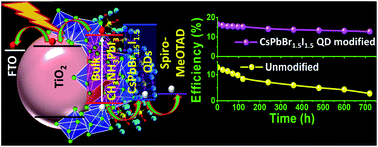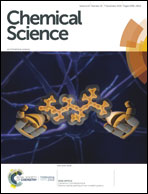All-inorganic quantum dot assisted enhanced charge extraction across the interfaces of bulk organo-halide perovskites for efficient and stable pin-hole free perovskite solar cells†
Abstract
In spite of achieving high power conversion efficiency (PCE), organo-halide perovskites suffer from long term stability issues. Especially the grain boundaries of polycrystalline perovskite films are considered as giant trapping sites for photo-generated carriers and therefore play an important role in charge transportation dynamics. Surface engineering via grain boundary modification is the most promising way to resolve this issue. A unique antisolvent-cum-quantum dot (QD) assisted grain boundary modification approach has been employed for creating monolithically grained, pin-hole free perovskite films, wherein the choice of all-inorganic CsPbBrxI3−x (x = 1–2) QDs is significant. The grain boundary filling by QDs facilitates the formation of compact films with 1–2 μm perovskite grains as compared to 300–500 nm grains in the unmodified films. The solar cells fabricated by CsPbBr1.5I1.5 QD modification yield a PCE of ∼16.5% as compared to ∼13% for the unmodified devices. X-ray photoelectron spectral analyses reveal that the sharing of electrons between the PbI6− framework in the bulk perovskite and Br− ions in CsPbBr1.5I1.5 QDs facilitates the charge transfer process while femtosecond transient absorption spectroscopy (fs-TAS) suggests quicker trap filling and enhanced charge carrier recombination lifetime. Considerable ambient stability up to ∼720 h with <20% PCE degradation firmly establishes the strategic QD modification of bulk perovskite films.



 Please wait while we load your content...
Please wait while we load your content...